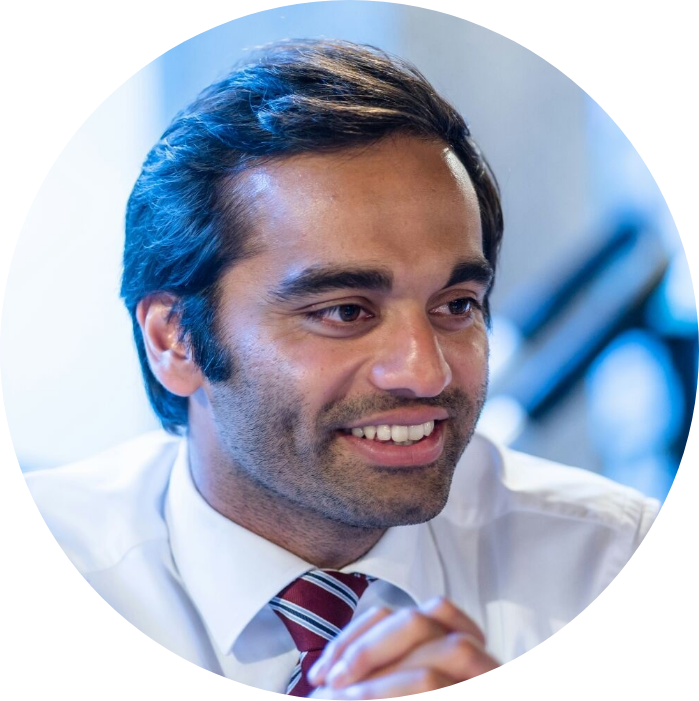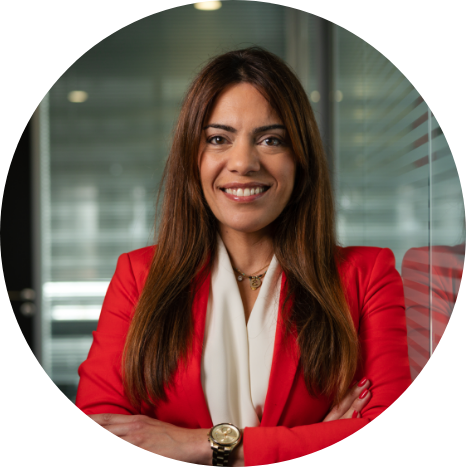Review the BAS 2025 Content
Explore the executive summaries and presentations from our speakers.
Everything you need to dive deeper into the topics shared at the event.

Marco Neves
Keynote: IA Generativa - Disrupção e Estratégia na Era da Transformação Digital
This thought-provoking presentation explores how Generative Artificial Intelligence (AI) is reshaping industries, professions, and strategies in a world moving toward cognitive automation. Drawing from historical technological revolutions and current AI trends, Marco Neves provides strategic insights for organizations and professionals on how to adapt, co-create, and lead in this era of exponential change.
Key Elements:
1. The Grand Paradox – Human vs. Machine Intelligence
· Raises the philosophical and practical question: Can machines think? (Turing, 1950).
· Highlights the challenge of aligning artificial cognition with human values and intelligence.
2. Evolutionary Context – From Muscle to Mind
· Traces four technological revolutions:
1st: Steam power – muscle substitution.
2nd: Electricity – force amplification.
3rd: Computing – process automation.
4th: Generative AI – cognitive emulation.
3. Technological Milestones
· From punched cards to cognitive digital agents.
· Key examples: ChatGPT, Claude, Gemini, Copilot, SORA, OpenAI Operator.
· 2024 marks a shift from multimodal AI (text, image, voice) to agentic models with reasoning capabilities (e.g., GPT-4o, o3/R1).
Disruption at Scale
· ChatGPT reached 100 million users in 2 months, faster than any other tech platform.
· Weekly active users surpassed 650 million by 2024.
· The shift from passive AI tools to interactive agents is redefining how we engage with software.
“Text-to-Everything” Paradigm
A single text prompt now enables the generation of:
· Text2Text: documents, poems, code.
· Text2Image, Text2Video, Text2Music.
· Text23D, Text2App, Text2Game, Text2Research. This reflects a massive expansion in the creative and operational capabilities of individuals and organizations.
AI Ecosystem Intelligence
· Introduces the growing ecosystem of AI tools and platforms:
SORA (video), Deep Researcher (analysis), Suno/Udio (music), MidJourney (image), VEO, Grok, Gemini, Claude, etc.
Emphasis on No-Code AI wrappers, enabling non-technical users to harness AI effectively.
Cognitive Automation Era
AI is no longer just a tool—it’s a collaborator.
Progressive automation stages: task → project → profession → teams → businesses → industries → economies.
A new human-AI collaboration model emerges, where professionals become co-creators alongside AI.
Strategic Response to AI
Neves introduces a strategic maturity ladder:
· N0: Ignore AI.
· N1: Experiment with tools (e.g., ChatGPT).
· N2: Use AI with no added value.
· N3: Integrate AI into core strategy.
He proposes “Mentadaptability” – a mindset of continuous learning, adaptation, and creative reinvention, essential to thrive in this new era.
Closing Message:
“AI is not just about technology—it’s about redefining how we think, create, and lead.”

João Filipe Rodrigues

Carlos Bhatt
Talk: Agilidade em movimento - a jornada de Inovação dos CTT
This presentation showcases the historic transformation and ongoing innovation strategy of CTT (Portugal’s national postal service). Rooted in over 500 years of evolution, CTT has developed a diversified portfolio beyond traditional mail—embracing express logistics, banking (Banco CTT), e-commerce, and financial services.
Key Elements:
· Innovation Governance: An Innovation Agenda with 56 ongoing initiatives, supported by 15 owners and 20 champions.
· Startup Ecosystem: Over 1,700 startups mapped, 14 commercial partnerships, and active co-innovation projects.
· Corporate VC Fund (1520): Invests €250k–€500k in strategic startups, especially in fintech, logistics, and e-commerce.
· Digital Products: Launch of a Super App and B2B Super Portal; rollout of AI chatbot “HELENA” using generative AI for customer service.
· Sustainability & PRR Projects: Robotic automation, mobility tracking, and electric vehicle infrastructure through EU-funded programs.
· Strategic Pillars: Preserve mail value, grow in e-commerce logistics, expand Banco CTT, and improve customer and operational experience.
The presentation covered the historical evolution of CTT, highlighting its ability to adapt and innovate over more than 500 years, from the visual telegraph to the digital age. The ongoing transformation process was highlighted, with a diversified portfolio of business areas, from traditional mail to Banco CTT, express and parcels, financial services and business solutions.
The main focus was on CTT’s Innovation Agenda, which includes more than 50 initiatives, including open innovation with startups and universities, intrapreneurship, corporate venture capital and structuring projects with European co-financing (PRR). Success stories were also presented, such as the Dott marketplace, the Locky locker network and the evolution of the CTT app into a super app.
CTT’s approach to innovation is supported by a collaborative architecture and tools that promote internal creativity and connection to the external ecosystem. Technological transformation was also highlighted, including the new IT operating model and the development of solutions such as the generative AI-based chatbot – “Helena”.

Andre Bocater Szeneszi
Talk: Como obter um retorno de 62 (X) sobre investimento - Não é sorte, é Governance!
In this insightful presentation, André Bocater, co-founder of wBrain and partner at K21 and Nower, explains how structured governance, strategic agility, and disciplined execution can deliver extraordinary business results. The central theme is clear: achieving exponential ROI—over 6,195% between 2018 and 2024—is not luck, but the outcome of intentional, well-aligned investments in people, processes, and technology.
Key Elements:
Investment Comparison (2018–2024):
Real Estate (Lisbon/Porto): +40–60%
Portuguese Stock Index (PSI-20): -10% to +5%
Global ETFs (e.g., S&P 500): +80–120%
Startups (e.g., OutSystems, Feedzai): +20–40% annually
Renewable Energy: 8–12% annually
wBrain: +6,195% ROI, with a compound annual growth rate (CAGR) of ~25%
Organizational Focus Areas:
Education and Capability Building: Equipping teams to face complex challenges through agile training.
Strategic Consulting: Using OKRs and modern governance tools to accelerate decision-making and execution.
Technology Development: Implementing digital solutions with agile teams and high delivery capacity.
Agile Governance and Business Agility:
Based on three main goals: deliver outcomes, enable learning, and expose issues.
Emphasis on reducing Lead Time and Time to Market, while enhancing transparency and cross-functional alignment.
wBrain’s Growth Trajectory (2018–2025):
Origins as a spin-off born from a partnership with Magmalab and K21.
Resilience during the pandemic, launching services in recruitment, agile outsourcing, and digital bootcamps.
Expansion to Portugal and international recognition, including GPTW certification and the “Melhores para o Brasil” Award (3x, Rating A).
Introduction of innovative services such as Squads wBrain and SyncDupli, a tool that automates the management of financial guarantees.
Cultural and Strategic Differentiators:
Implementation of O2 (Organic Organization) governance to empower autonomy and collaboration.
Focus on humanized leadership, inclusive practices, and stakeholder-centric strategies.
Internal self-reflection and leadership development initiatives to continuously raise performance standards.

José Faria
Talk: From KPIs to OKRs - A New Era of Goal Management
This presentation shares Worten’s journey transitioning from traditional KPIs to Objectives and Key Results (OKRs), aiming to create a more focused, transparent, and adaptive performance culture.
Key Elements:
· KPIs are no longer sufficient to drive growth in a fast-changing world.
· OKRs bring clarity, alignment, and motivation, correcting several limitations of KPI-driven management.
· Worten aligned OKRs with strategic horizons and cross-functional leadership.
· Examples of active OKRs:
Boost Apple services
Service subscription growth
NSS Repairs (a recognized area of service leadership)
· Strategic goal: Establish Worten as the leading repair & home solution expert in Portugal.
Takeaway:
Worten’s OKR adoption reflects a culture shift from control to empowerment, aiming to foster ownership, customer-centricity, and agility in execution at all organizational levels.

Alexandre Inácio
Workshop: Transforme o seu Propósito em Resultados com OKRs
This presentation by Agile Coach Alexandre Inácio introduces a practical and strategic approach to deploying OKRs (Objectives and Key Results) as a way to translate purpose into measurable, actionable outcomes in organizations.
Key Elements:
1. Three Core Principles of OKRs:
a. Purpose Clarity: Without a clear direction, organizational efforts become fragmented. The purpose acts as a compass.
b. Specific and Measurable Key Results: Key Results operationalize the Objectives, transforming aspirations into trackable outcomes. Good KRs follow the SMART criteria (Specific, Measurable, Ambitious, Relevant, Time-bound).
c. Monitoring and Flexibility: OKRs must be revisited regularly to track progress and adjust initiatives accordingly—emphasizing agility over rigidity.
2. Practical Application – Case Study:
a. A real implementation within a Customer Management and Digital Performance department of a global banking entity in Portugal.
b. 7-step framework:
i. Leadership awareness and engagement.
ii. Definition of strategic vision.
iii. Co-definition of Objectives (O).
iv. Collaborative identification of Key Results (KR).
v. Transparent communication of OKRs.
vi. Prioritization of supporting initiatives.
vii. Quarterly planning and execution (e.g., Q1 planning).
3. Results Achieved:
a. 86% of OKRs reached.
b. Lead Time reduced by 9.8%.
c. Cycle Time improved by 40.7%.
d. Gains in strategic alignment, organizational cohesion, operational efficiency, and a culture of innovation and continuous improvement.
4. Interactive Exercise:
a. Participants simulate being CEOs: define vision, objectives, key results, and initiatives for a real challenge.
b. Purpose: bridge theory and practice, reinforcing strategic thinking and execution planning.

David J. Anderson
Keynote: Enterprise Services Planning - a service-oriented approach to very large scale business agility
This talk redefines business agility around services instead of teams. It proposes service-oriented design as a scalable and adaptable model for modern organizations, using Kanban systems to coordinate across services without reorganization.
Key Elements:
· A service is the molecular unit of agility—not a team.
· Focus on cooperation, not restructuring.
· Introduces the Delivery Manager as a coordination role across functions.
· Describes 6 Practices to Enable Business Agility, including:
1. Services as the first level of scale.
2. Alignment through shared context.
3. Kanban for managing dependencies.
4. Feedback loops (inner and outer).
5. Fit-for-purpose measurement (“satisficing”).
6. Dynamic reservation systems to handle uncertainty.
Takeaway:
Organizations must shift from team-based agility to service networks, enabling large-scale responsiveness through trust, coordination, and continuous learning—without falling into the trap of constant reorgs.

Anthony Simões

Gustavo Neves

Fedra Medeiros

Rui Gomes
Round table: M.ER.D.A. - Muito ERro da Aprendizado
This is the first scientific study focused on agility as experienced in Portugal, based on feedback directly from professionals in the field. Rather than perpetuating theoretical or imported frameworks, this research offers evidence-based insights into the real state of agile practices in Portuguese organizations.
The name M.E.R.D.A. (Muito Erro Dá Aprendizado – “A Lot of Mistakes Leads to Learning”) reflects the core philosophy: learning through real-world challenges, not perfection.
Key Elements:
1. Disconnection Between Business and Technology
67% of respondents reported a lack of alignment between business teams and IT teams, undermining true cross-functional agility.
2. Hierarchical Decision-Making
65% indicated a top-down culture, where decisions are made by upper management and communicated in a cascade model.
Despite discussions about decentralization, approvals still happen at the top, limiting autonomy.
3. Project Thinking Over Product Thinking
63% still approach work as discrete projects (start, middle, end) rather than embracing ongoing, evolutionary product development.
4. Control & Command Mindset
61% perceive a persistent mindset of control and fixed planning, misaligned with adaptive agile principles.
5. Fear of Failure
A significant 72% noted a strong organizational fear of making mistakes, often reinforced through direct or indirect punishment.
Psychological safety is seen more as a trend than a lived reality.
6. Agility Perceived as an IT Concern
Many organizations still associate agility primarily with IT, limiting its strategic and organizational impact.
Research Purpose
To map the Portuguese agile ecosystem as it truly exists, providing a mirror rather than a model. This enables leaders and practitioners to identify systemic gaps, foster cultural shifts, and make informed adjustments rooted in context, not assumption.
Call to Action
The study encourages companies and agile practitioners to:
· Embrace bottom-up participation.
· Shift focus from tools and buzzwords to genuine collaboration and learning.
· Access the full study and participate in the next research cycle through the provided contact links.

Patricia Alves Sousa
Talk: TA Transformation Journey - A New Way of Working
Celfocus undertook a major transformation of its Talent Acquisition (TA) strategy starting in late 2022. This initiative aimed to address internal inefficiencies, technological gaps, and a disconnection between recruitment processes and business needs. The journey evolved across three key phases: Recruitment 1.0 (2023), Recruitment 2.0 (2024), and the HORIZON phase (2025).
Challenges Identified
· Lack of cohesive leadership and team integration.
· Poor data management, excessive use of Excel, and low data reliability.
· Misaligned communication with business stakeholders.
· Heavy dependency on outsourcing.
· Increasing competition in talent markets and rapid technological evolution.
Strategic Approach
Celfocus embraced Agile principles, empowering recruiters to act as Product Owners, adopting a product-centric model and structured sprint cycles. Emphasis was placed on autonomy, transparency, collaboration, and continuous feedback. The team was encouraged to test new methods and view mistakes as learning opportunities.
Key Initiatives and Milestones
· Agile Adoption: Internal Agile training, sprint planning, retrospectives, and time-boxed meetings.
· Data Transformation: Transition from Excel reporting to Power BI dashboards, automation via API integrations, and a shift to a data-driven culture.
· Product-Oriented Delivery (PODs): Cross-functional teams with clear goals, focused on experience and efficiency.
· Process Redesign: Inclusive recruitment, structured workflows, and enhanced stakeholder engagement.
· Vision and Culture: Defined mission, vision, values, and a customer experience-driven mindset.
2025 Vision – Horizon
The focus is on consolidating gains, exploring AI integration (e.g., GenAI in recruitment), and refining the customer journey mindset. Future plans include deeper implementation of PODs and ongoing culture reinforcement.
Challenges Overcome
· Breaking the myth that Agile is only for IT.
· Managing resistance to change.
· Aligning the TA team with business realities.
· Fostering autonomy with accountability.
· Tailoring Agile to a non-tech environment through a gradual, iterative approach.

Andrea Murata
Talk: Business Agility in the Public Sector - How Agile Practices Transformed a European Public Agency
Andréa Murata outlines a compelling case of public sector transformation at the European Union Drugs Agency (EUDA), using agile practices to overcome challenges related to new mandates, lack of clarity, and siloed structures. The presentation illustrates how agility is being redefined in bureaucratic settings—less about rituals and more about intentionality, visibility, and collaboration.
Key Elements:
1. Initial Challenges:
a. Complex new mandates and services with little prior experience.
b. Small teams, high workload, decentralized information, and poor collaboration.
c. Difficulty prioritizing under pressure.
2. Agile Mindset Shift:
a. Focus on self-responsibility, connection to purpose, and short feedback cycles.
b. Agile practices applied with intention rather than ritual: co-creation, continuous learning, and empowered teams.
3. Pilot with EVDnC Approach:
a. Stands for Empathy, Vision, Design and Co-Creation.
b. Involved 5 cross-sectoral units, creating shared ownership, reducing silos, and aligning around one unified objective.
c. Facilitation was key: a facilitator helped mediate between Core Team, Reviewers, and Stakeholders.
4. Measurable Outcomes:
a. 10x learning acceleration: 2.5 months of insight in 1 week.
b. 100% of prioritized research questions addressed in one sprint.
c. Better, clearer, and more client-aligned reports.
d. Internal champions started promoting agility organically across departments.
5. Cultural Impact:
a. Agility helped reframe how collaboration happens across EUDA.
b. New narratives emerged—from uncertainty to learning, from silos to shared goals, and from command/control to co-production.

Marianne Henriques

Danilo Ferrari

Adilson Simões
Talk: Do processo à maturidade ágil: Como os comportamentos podem acelerar decisões e entregas
This presentation outlines Fidelidade’s journey toward agile maturity, emphasizing the role of team behaviors in improving delivery performance, decision-making speed, and organizational agility. Rather than focusing solely on frameworks and tools, the team highlights the importance of observable behaviors that signal real agility in practice.
Context & Evolution:
· Starting in 2018 with 12 Scrum teams, Fidelidade has scaled to 50+ Scrum and Kanban teams by 2024, across multiple business and technical units.
· The initiative, branded FIT (Fidelidade IT Transformation), evolved through two phases:
FIT 1.0: Agile lighthouse teams and early Scrum adoption.
FIT 2.0: Integration of Infrastructure roles, improved value alignment, governance optimization, and a structured demand process (ABRs) to link business intentions with delivery.
Strategic Goals:
· Scale agility across the organization while maintaining autonomy and accountability.
· Improve business alignment and delivery cadence.
· Introduce different team topologies beyond Scrum (e.g., Kanban, Platform Teams).
· Empower teams with greater decision-making authority and cross-functional structure.
Key Achievements:
· 55% increase in delivery frequency.
· 8/10 average satisfaction with agile ways of working.
· Adoption of MVP (Minimum Viable Product) mindset across the organization.
· Agile culture increasingly embedded across diverse teams.
Behavioral Model & Pilot:
· A structured behavioral assessment model was introduced, focusing on six key dimensions:
Planning
Delivery
Continuous Improvement
Learning
Team Agreements
Backlog Management
· Each team was evaluated for specific behaviors, such as:
Using daily stand-ups to adjust and self-organize.
Actively managing technical debt.
Making data-driven decisions in retrospectives.
Using DoR (Definition of Ready), DoD (Definition of Done), and working agreements visibly.
· Baseline findings (Oct 2023): On average, teams showed ~40% of expected minimum behaviors. The goal was to identify improvement areas and define actionable steps.
Team Improvement Model:
· Weekly observation of 3 teams over 10 weeks (~30 teams total).
· Used heatmaps, radar charts, and maturity dashboards to track progress and engagement.
· Observations were followed by shared reflections and team-specific action plans.
Next Steps:
· Expand the number of teams undergoing behavioral coaching and observation.
· Increase maturity beyond foundational behaviors.
· Consolidate an organizational culture where agility is not just about processes or tools, but about how teams think, collaborate, and evolve.
Core Message:
“Agility is not about having tools. It’s about cultivating behaviors that drive real change—while enjoying the process.”

Frederico Silva
Talk: EVNDnC @ CA - A Agilidade enquanto Acelerador do Cumprimento Regulamentar
This case study details how Crédito Agrícola used an agile coaching framework (EVNDnC – Extreme Value-Driven Coaching) to meet a tight regulatory compliance deadline involving a bond issuance for Sporting SAD.
Key Elements:
Context & Challenge:
· Regulatory compliance with CMVM Circular 18/2023.
· One-week deadline with high reputational and financial risk.
· Need for full alignment across multiple internal teams (Legal, Business, IT).
Approach:
· Agile Sprint-Based Coaching: Daily planning, delivery, feedback, and retrospectives over 5 days.
· Prioritized User Stories: Delivered only the essential items for compliance (“Must Haves”), discarding 70% of less critical items.
· Tangible Benefits:
Lead Time Reduced by 58% (from 29 to 12 calendar days).
€40K+ in FTE Savings
Higher collaboration and business-tech alignment.
Feedback: Participants praised the accelerated learning, focus on value, and significant shift in mindset and team dynamics.
Watch or rewatch the moments that defined BAS 2025.
See you next year!